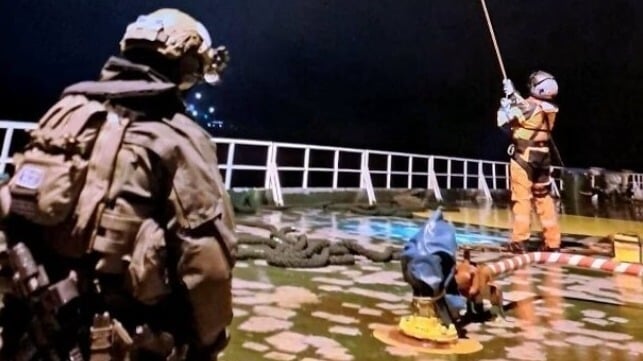Experts Scrutinize "Accident" Explanation for Baltic Cable Damage

Over the past week, U.S. and Finnish intelligence officials have told media that there is no evidence that Russia was behind the cutting of five subsea cables in the Gulf of Finland on Christmas Day, and that the tanker that caused the damage likely dragged anchor for 50 miles by accident. But the "accident" claim is drawing pushback in Finland and Sweden, which were affected most by recent suspected subsea sabotage.
The incident on Dec. 25-26 was the third time in a year that a Russia-linked ship has been accused of severing multiple subsea cables by dragging an anchor under power for unusual distances. This time, NATO has assembled a large naval task force to monitor the area and ensure the security of Baltic subsea infrastructure.
"If all of these are really just accidents, why are they being monitored militarily?" Finnish MEP Mika Aaltola asked in a conversation with Ilta-Sanomat. "It's obvious why there's a military response to it. You'd have to be pretty stupid not to understand that."
The U.S.-sourced "accident" explanation was likely intended to reduce tension with Russia, said Aaltola. He suggested that the Biden administration's outgoing national security team may simply have wanted to minimize risk during the presidential transition. "Russia is waging war in Ukraine, we are focusing on the essentials, we do not want to cause a painful, or geographical, escalation elsewhere. Russia's damage [to subsea infrastructure] is limited and can be repaired, so we would rather accept these attacks than make a big fuss about them," Aaltola surmised.
Others suggest that the "accident" announcement was simply premature, and that the investigation is still far from completed. "This kind of information comes and goes," Swedish Minister of Defense Pal Jonson told SVT.
Multiple outlets have reported that the Finnish investigation has found no evidence yet of a Russian "hybrid" sabotage attack, after four weeks of looking. A lack of evidence would be expected in a well-run sabotage operation, explains Lieutenant Colonel Juhani Pihlajamata (ret'd) - and is not itself proof of an accident.
"Efforts have been made to keep the matter as secret as possible. In other words, the lack of results in the investigation only leaves the perpetrator or the person who ordered it open. It does not rule out Russian involvement," Pihlajamata told Ilta-Sanomat.
Given the technical odds of having an anchor lower itself to the bottom and secure itself, without the crew's detection - three times in one year - some experts are ready to rule out accidental causes.
"When the numerous breakdowns are combined with the fact that Russian reconnaissance vessels have been exceptionally careful in examining these areas before the events, I personally cannot believe in coincidence or accident," said Prof. Kari Liuhto, professor of intelligence research at the University of Turku, speaking to IS.
Finnish police continue to pursue a criminal sabotage investigation aboard Eagle S, and have issued travel bans to nine crewmembers suspected of causing the damage. The master and one other crewmember appealed the travel ban on Friday, attempting to have it reversed.
